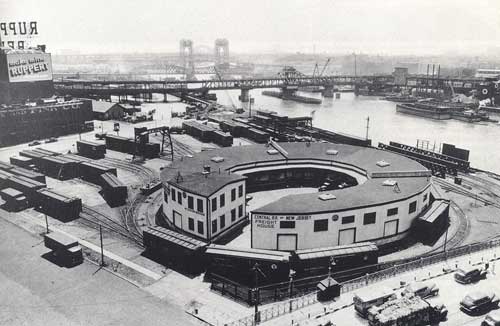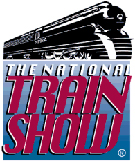The CNJ Bronx Freight Terminal
Guest author Paolo Sforza
Shortly after starting on the Bronx Terminal build, I was contacted by Paolo Sforza, a modeler in the UK who is also working on building the CNJ Terminal. We have been exchanging details about the terminal (mostly him sending me stuff) and has been kind enough to write a well informed background biography about the terminal. I thought you might find it interesting, I know I sure did!
Thanks Paolo….
-Tim
CNJ Bronx Terminal
A Historical Biography
by Paolo Sforza
By 1900 the population of New York City approached 3 million, a third of whom lived in the Bronx. Some of the very factors that had allowed the City to grow so rapidly, navigable waterways, also acted as barriers to the newer types of transportation, the railroads, from reaching the center of the new metropolis. Bridges and tunnels are expensive to build and maintain, and the Hudson, East and Harlem Rivers are not small by any standards. Back then, motor transport was in its infancy. Once the railroads from the west reached the New Jersey shore the rails simply ran out at the waters edge. The solution was to float the freight cars to various small receiving yards along the Manhattan, Brooklyn and Bronx waterfronts and a myriad of these small yards sprang up in the late 19th and early 20th Centuries. One such yard, a comparative late comer was the Central Rail Road of New Jersey (aka The Jersey Central or the CNJ) Bronx Terminal, situated on the north shore of the Harlem River where Third Avenue crosses from Manhattan to the Bronx. From here the yard could serve both the Bronx itself and northern Manhattan. The Bronx Terminal wasn’t alone along this stretch of waterfront; immediately to the east was the huge main yard of the New York, New Haven & Hartford RR and to the west the much smaller yards of the Delaware, Lackawanna & Western (as the Harlem Transfer), the Erie, and the Lehigh Valley railroads occupied the busy waterfront. The CNJ’s huge main yard that fed its Bronx Terminal, amongst others, was at Communipaw on the Jersey City side of the Hudson River.
Freight cars were transferred around New York Harbor on carfloats, which typically carried around 15 cars. The carfloats were not powered, but towed and pushed by tugs – initially these were steam and, later, diesel powered. Loading cars from yard to carfloat was via a floatbridge which was hinged to the land at one end allowing the free end to rise and fall with the water level. Remember that the waters around New York City are tidal. Floatbridges had variations on a theme, but the principles are the same. Carfloats were brought end-on to the floatbridge by the tug and positioned using lines and windlass, and then anchored to the floatbridge by large bolts. Unloading and loading carfloats could be tricky, and to keep the carfloat balanced heavy locomotives usually weren’t allowed on the carfloat, but reached the cars using an intervening idler flat car. Various railroads, including the CNJ, also used covered barges and lighters (boats with their own on-board crane) to move goods around the area.
The smaller yards were made up of general merchandise (less-than-a-carload or LCL) facilities, requiring a freight house where goods could be dropped off, collected and stored. There would also be team tracks where cars could be unloaded directly onto horse wagons and later, motor trucks. Some yards also contained industry tracks serving particular customers, although initially the Bronx Terminal didn’t have any such tracks.
The Bronx Terminal first opened on August 16th, 1907 on a small plot bounded by Third Ave to the west, Southern Ave/E133rd Street (now Bruckner Blvd) to the north, Lincoln Ave to the west and the Harlem River to the south. The area had been, as late as 1905, partly underwater as a series wharves and berths for cargo boats until the CNJ gained the lease in early 1905. The area had been subsequently filled in and flattened and a new river wall built.
A feature of the yard was the multi-sided freight house with center courtyard. Although interesting and unusual, the freight house wasn’t very practical and became more difficult to use as boxcars became bigger as the years passed. The distance between the rail-side doors was based on the spacing required for 36ft cars when in a rake, but once the 40ft car became the norm then a continuous rake of cars could no longer be lined up with their own doors adjacent to those of the freight house. The rake of cars either needed to be split or successively moved for unloading. In addition, the central courtyard must have been increasingly difficult to manoeuvre around as delivery truck grew in size. The Bronx Terminal shared its unusual basic design with that of the neighboring Harlem Transfer, which had been operating for some years when horse transport and smaller boxcars had been usual.
The trackwork of the original yard remained largely unchanged during the life of the yard and consisted of double ring of track circling the freight house, two feeder tracks to the floatbridge and 17 team tracks of various lengths. Fitting this amount of rail in such a small space required some pretty sharp radii (90ft minimum and 104ft maximum), guard rails to protect against derailments, several three-way switches, diamond crossings and some fancy slipwork. In 1911 the riverside on the west of the Third Ave Bridge was leased from City and one can presume that the first extension of the yard occurred soon after by putting a track though the existing tunnel under the Third Ave Bridge ramp. By the early 1920s a wye track had been created using two of the team tracks, and an engine house built on platform on piles over the river. All this required some even fancier trackwork in the area of the tunnel and engine shed, made still more complex later as the area to the west of Third Ave became increasingly important and a track from the outer ring built to allow easier access. The switch work was so complex in this area that the rails to the engine house were made removable so as not to foul the points and only temporarily laid in place when the loco was housed. Minor changes to crossovers also marked the usual transition from initial design in the light of practical switching experience.
The area to the west of Third Ave had originally been occupied by the extensive Mott Iron Works, but these had relocated to Trenton in 1906 leaving the buildings available for smaller businesses to move in to the site. Although some of these rail-served industries are known, much more research is required to identify others and clarify dates of operation.
The yard seems to have ticked along with a series of solitary locomotives for most of its lifetime. The first of these was CNJ 840, a tiny Baldwin 0-4-0 side tank, which served at the yard until 1925 when it was recalled to Communipaw to work as a roundhouse goat. The replacement was the historically important ALCo-General Electric-Ingersol Rand (AGEIR) 300hp boxcab (CNJ 1000), the first commercially successful diesel-electric locomotive in the US. In 1925, New York City had passed anti-smoke ordinances banning steam locos, which required the rapid switch from steam to diesel. Whether the CNJ ever expected this novel beast to be working well into the 1950s is anyone’s guess, but last it did, as it still does, in honourable retirement at the Baltimore & Ohio RR Museum.
1927-28 saw major changes to the yard operations with the construction of the “New Yard”, an extension to serve the old-Mott site, part of which had been redeveloped and much of the rest leveled, although some of the original Mott building remained and remain to this day. The New Yard was bounded by the Mott Haven Canal to the west, 135th Street to the north, although the majority of the tracks ran close to the perimeter of the site to the south, west and north. Just a single track went into the heart of the site serving a 1928 building that initially housed a CNJ light engineering facility. Other businesses at various times covered a wide range covering motor truck building, knitwear, tea distribution, roofing supplies and flooring manufacturing. However, the staple of this part of the yard was domestic and industrial fuel with the yard dominated by a large 6-silo coal elevator. The CNJ was, after all, one of the anthracite lines (along with the Lehigh Valley RR, and the Reading Lines, transporting coal from the Pennsylvania and West Virginia mines to the eastern seaboard.
The yard continued without much change through Prohibition and the bust and boom of the Depression and WWII eras, but by the early 1950s boxcab 1000 was showing signs of age and was temporarily replaced by CNJ 1023, an ALCo high-hood HH600. The HH series weren’t big engines by any means, but even 1023 required extended couplers to cope with the sharp radii. When 1000 was finally withdrawn to the CNJ Elizabethport yard in 1954, the permanent replacement wasn’t a HH unit, but a diminutive Davenport 35T gas-mechanical loco. Around this time it became the practice to ship the loco by carfloat from and to Communipaw on the day’s first and last carfloats. The Mott Haven area of the Bronx had been in economic decline for years and vandalism had become rife. Without a resident loco, the engine house was removed.Change also affected the CNJ’s tug fleet with conversion from steam to diesel being completed between 1952-53.
Carfloating had served New York City well up to the 1950s, but a steady decline in rail traffic had set in and the Bronx Terminal became one of the earliest victims of this downturn. The area occupied by the original yard was reduced in 1959 to just the three team tracksnearest the river – which could all be accessed by the yard’s travelling crane, some repositioned access tracks, and the Third Ave Bridge tunnel track. Around this time all the other tracks were lifted and the freight house demolished. The remaining industry tracks to the west were now the most important parts of the yard; general LCL merchandise traffic having become increasingly unprofitable and much south Bronx industry closing or relocating.
The yard closed completely on November 27th, 1961 and CNJ 1001 sold for scrap in 1963.
The CNJ itself went though the usual trials of regional railroads of the 1960s and 1970s and was incorporated into Conrail in 1976.
The shorelines of Manhattan, Brooklyn, and the Bronx still contain many decaying remnants of rail-marine operations, but little is left to mark the Bronx Terminal save some overgrown rails in the old Mott area. Nothing at all remains of the old yard and the site is once again destined for redevelopment. The shoreline has changed, the Third Avenue Bridge completely rebuilt and the Mott Haven Canal filled in. However, railroads haven’t completely disappeared as the later-built Hudson Line of the MTA’s Metro North trains now speed commuters over the exact spot where the Bronx Terminal’s carfloats once docked.
About the Author:
I'm your host, Tim Warris, a product developer in Port Dover, Ontario. Since March of 2007 I have been documenting the construction of the former CNJ Bronx Terminal in HO scale. For my day job, I design track building tools for Fast Tracks, a small company I own and operate. Fast Tracks makes it fast and easy to hand lay your own trackwork. Stop by our website to learn more!
Posted by: Tim | 04-17-2007 | 09:04 PM
Posted in: Latest Posts | Prototype Information (the real stuff)

